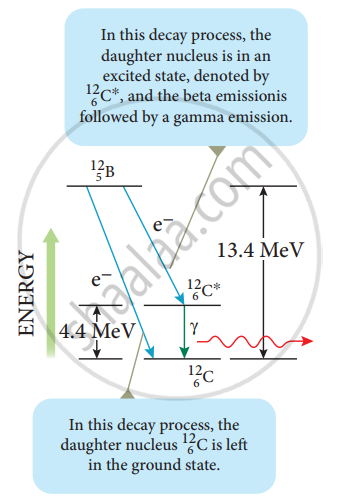Advertisements
Advertisements
Question
Discuss the gamma decay process with an example.
Solution
In α and β decay, the daughter nucleus is in the excited state most of the time. The typical life time of excited state is approximately 10-11 s. So this excited state nucleus immediately returns to the ground state or lower energy state by emitting highly energetic photons called γ rays. In fact, when the atom is in the excited state, it returns to the ground state by emitting photons of energy in the order of a few eV. But when the excited state nucleus returns to its ground state, it emits a highly energetic photon (γ rays) of energy in the order of MeV. The gamma decay is given by
\[\ce{^A_ZX^* -> ^A_ZX + gamma (γ) rays}\]

Gamma emission
Here the asterisk (*) means excited state nucleus. In gamma decay, there is no change in the mass number or an atomic number of the nucleus.
Boron \[\ce{^12_5B}\] has two beta decay modes:
-
It undergoes beta decay directly into ground state carbon by emitting an electron of a maximum of energy 13.4 MeV.
- it undergoes beta decay to an excited state of carbon \[\ce{^12_6C^*}\] by emitting an electron of maximum energy 9.0 MeV followed by gamma decay to ground state by emitting a photon of energy 4.4 MeV.
It is represented by
\[\ce{^12_5B -> ^12_6C + e- + \bar{v}}\]
\[\ce{^12_6C^* -> ^12_6C + \gamma}\]
APPEARS IN
RELATED QUESTIONS
Write two units of radioactivity. How are they interrelated?
In alpha decay, why the unstable nucleus emits \[\ce{^4_2He}\] nucleus? Why it does not emit four separate nucleons?
What is meant by activity or decay rate? Give its unit.
What are the constituent particles of neutron and proton?
Discuss the beta decay process with examples.
Obtain the law of radioactivity.
Discuss the properties of neutrino and its role in beta decay.
Calculate the time required for 60% of a sample of radon to undergo decay. Given T1/2 of radon = 3.8 days.
If T is the half-life of radioactive material, then the fraction that would remain after a time `"T"/2` is:
The radio active decay of uranium into thorium is expressed by the 92U238 `->` 90Th234 + x where x is
